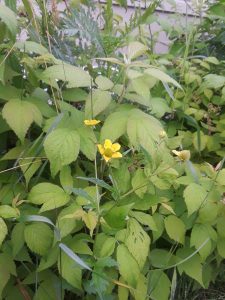Yellow Avens
 Geum aleppicum was growing midst the shady protection of some raspberry brambles in this photo when I first came across it. Like its cousin, white avens, yellow avens belongs to the Rose family. In June, the yellow version joins its cousin (which has already been blooming since May) to adorn shady thickets and woods from early to late summer (June/July). Habitat also includes the part shade of my woodland garden where the Avens’ are always welcome to remain as long as they wish!
Geum aleppicum was growing midst the shady protection of some raspberry brambles in this photo when I first came across it. Like its cousin, white avens, yellow avens belongs to the Rose family. In June, the yellow version joins its cousin (which has already been blooming since May) to adorn shady thickets and woods from early to late summer (June/July). Habitat also includes the part shade of my woodland garden where the Avens’ are always welcome to remain as long as they wish!
Compared to white avens, yellow avens has a bit more robustness going on although the general structure of the plant is the same with flowers appearing singly at the end of long stalks in the upper part of the plant The flower buds arise from the leaf axils towards the top where the main stem branches out. Differences are that the flower petals of the 1/2″ flowers are wider and rounder, allowing less room for the 5 green sepals to peek through — but they still do. Also, there is more hairiness of the stem and leaves with all surfaces thickly covered..
LEDITike white avens, yellow avens has basal leaves that are pinnately compound with the end leaflet being the largest, sometimes lobed. Side leaflets on the basal leaf are smaller with 2 to 6 pairs below the end leaflet. Stem leaves are also compound, just that there are only 2 side leaflets and they are very small, with 2 stipules in the leaf axil. As the leaves ascend the stem, however, they become palmately compound are in the leaf axil. except that they are palmately compound in 3s with coarsely toothed edges, and become smaller the higher they go up the stem until towards the top they become simple leaves ( no longer compound), appearing singly on the stem. Stem is somewhat hairy, leaves variably so.
In contrast with white avens, yellow avens has several medicinal uses. Specifically, compounds within the plant have painkilling properties. Yellow avens should be used for only one or two days for this, however. A poultice can be helpful for skin wounds and diseases. A decoction of the roots treats coughs, sore throats and eases the pain from teething.
